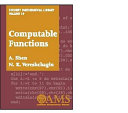Classical and Quantum Computation
sij 2002. · American Mathematical Soc.
E-knjiga
257
str.
reportOcjene i recenzije nisu potvrđene Saznajte više
O ovoj e-knjizi
This book is an introduction to a new rapidly developing topic: the theory of quantum computing. It begins with the basics of classical theory of computation: Turing machines, Boolean circuits, parallel algorithms, probabilistic computation, NP-complete problems, and the idea of complexity of an algorithm. The second part of the book provides an exposition of quantum computation theory. It starts with the introduction of general quantum formalism (pure states, density matrices, andsuperoperators), universal gate sets and approximation theorems. Then the authors study various quantum computation algorithms: Grover's algorithm, Shor's factoring algorithm, and the Abelian hidden subgroup problem. In concluding sections, several related topics are discussed (parallel quantumcomputation, a quantum analog of NP-completeness, and quantum error-correcting codes). Rapid development of quantum computing started in 1994 with a stunning suggestion by Peter Shor to use quantum computation for factoring large numbers-an extremely difficult and time-consuming problem when using a conventional computer. Shor's result spawned a burst of activity in designing new algorithms and in attempting to actually build quantum computers. Currently, the progress is much more significantin the former: A sound theoretical basis of quantum computing is under development and many algorithms have been suggested. In this concise text, the authors provide solid foundations to the theory-in particular, a careful analysis of the quantum circuit model-and cover selected topics in depth. Someof the results have not appeared elsewhere while others improve on existing works. Included are a complete proof of the Solovay-Kitaev theorem with accurate algorithm complexity bounds, approximation of unitary operators by circuits of doubly logarithmic depth. Among other interesting topics are toric codes and their relation to the anyon approach to quantum computing. Prerequisites are very modest and include linear algebra, elements of group theory and probability, and the notion of a formalor an intuitive algorithm. This text is suitable for a course in quantum computation for graduate students in mathematics, physics, or computer science. More than 100 problems (most of them with complete solutions) and an appendix summarizing the necessary results are a very useful addition to thebook. It is available in both hardcover and softcover editions.
Ocijenite ovu e-knjigu
Recite nam što mislite.
Informacije o čitanju
Pametni telefoni i tableti
Instalirajte aplikaciju Google Play knjige za Android i iPad/iPhone. Automatski se sinkronizira s vašim računom i omogućuje vam da čitate online ili offline gdje god bili.
Prijenosna i stolna računala
Audioknjige kupljene na Google Playu možete slušati pomoću web-preglednika na računalu.
Elektronički čitači i ostali uređaji
Za čitanje na uređajima s elektroničkom tintom, kao što su Kobo e-čitači, trebate preuzeti datoteku i prenijeti je na svoj uređaj. Slijedite detaljne upute u centru za pomoć za prijenos datoteka na podržane e-čitače.







